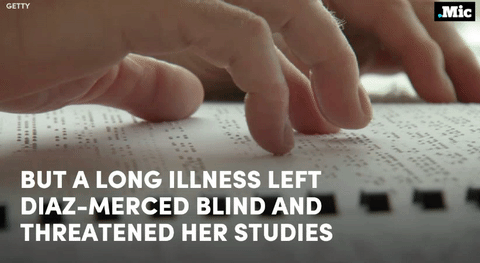Rosemary Johnson Was A Promising Violinist And Member Of The Welsh National Opera Orchestra When She

Rosemary Johnson was a promising violinist and member of the Welsh National Opera Orchestra when she was involved in a devastating car crash 27 years ago. The accident left her in a coma for seven months, and the resulting brain damage has robbed her of most of her ability to talk and move.
But thanks to new software that reads people’s brain waves, Johnson has been able to compose music for the first time since 1988, and has had the chance to have it played to her in real time by a professional string quartet.
“It was really very moving,” Eduardo Miranda from the Interdisciplinary Centre for Computer Music Research at Plymouth University in the UK, told The Telegraph.
More Posts from Curiositytherover and Others

Glowing bandages can reduce the chances of antibiotic-resistant bugs






This is Tech Tats, tattoos that can track your health data and your personal information - watch the full video











follow @the-future-now


You can grab and fold this drone without hurting yourself

Scientists Get Their First Glimpse At How New Memories Are Born
This is the closest we’ve come to watching new memories form in real time… http://futurism.com/scientists-get-first-glimpse-new-memories-born/
The Force Awakens: China Readies for Space Warfare
Moscow (Sputnik) Jan 01, 2016 The Chinese military is undergoing a gradual shift to cyber and space warfare, and the move is more visible now as a new command structure has been created. After testing an anti-satellite weapon last fall, China moved one step forward in its preparations for future warfare, with the emergence of a brand-new Space Force, as reported by Washington Times. In the event of an armed confl Full article

Amazon Unveils New Prime Air Drones. See It In Action
Amazon gives the world a glimpse of the future today, as they unveiled the Prime Air drone, which promises to deliver packages in under 30 minutes.
The Prime Air prototype, which weighs 24 kg (55 pounds), can carry packages of up to 2.2 kg (5 pounds) and is designed to fly under 152 meters (400 feet). It is also equipped with “sense and avoid” technology, which will allow it to dodge obstacles that it may encounter en route to its point of delivery.
Our video illustrates its features, and it takes you through the step-by-step process of how the unmanned aerial device will operate.
See the video at at: http://futurism.com/links/amazon-unveils-new-prime-air-drones/

(Fact Source) Follow Ultrafacts for more facts

We pulled together the week’s top tech stories, just for you:
1. Formula E is planning the first racing series for driverless cars You read that right: Before every Formula E race, two autonomous vehicles will go head-to-headlights, in a race straight out of every Sci-Fi fan’s wildest dreams. via: @engadget
2. How Technology Will Transform Retirement Someday in the near future, being selfish and obsessed with technology might be qualities that senior citizens praise today’s Millennials for. All around the world, young people are hard at work creating technology that will take care of them when they’re older. via: The Wall Street Journal
3. Who’s going to fly those Amazon delivery drones? The short answer is, probably no one. Which is for the best, really. After all, the real reason we don’t have flying cars is because people are bad drivers. And adding a z axis would be like trying to navigate rush-hour traffic in midair. via: ZDNet
4. Wayfindr Is on a Quest to Optimize Cities for the Visually Impaired After a successful experiment at London’s Pimlico Station and a recently received grant of $1 million from Google.org, this company wants to change the way visually impaired commuters navigate the London Underground. via: @wired

Russia will send these robots to space in place of humans
The anthropomorphic bot is a collaboration between robotics lab Android Technics and TsNIIMash, a Russian institute for building machines, according to Sputnik International. Alexander Permyakov, Director-General of Android Technics, told the news agency that these robots will be able to “completely replace human” in certain circumstances.
Follow @the-future-now
-
 grey-bard liked this · 7 years ago
grey-bard liked this · 7 years ago -
 geirhildur liked this · 7 years ago
geirhildur liked this · 7 years ago -
 weirdlet liked this · 7 years ago
weirdlet liked this · 7 years ago -
 beboots reblogged this · 7 years ago
beboots reblogged this · 7 years ago -
 mosellegreen reblogged this · 7 years ago
mosellegreen reblogged this · 7 years ago -
 mosellegreen liked this · 7 years ago
mosellegreen liked this · 7 years ago -
 19thschuylerplace reblogged this · 8 years ago
19thschuylerplace reblogged this · 8 years ago -
 utot-atbp liked this · 9 years ago
utot-atbp liked this · 9 years ago -
 admiraljane reblogged this · 9 years ago
admiraljane reblogged this · 9 years ago -
 admiraljane liked this · 9 years ago
admiraljane liked this · 9 years ago -
 selfrescuingprincesssociety reblogged this · 9 years ago
selfrescuingprincesssociety reblogged this · 9 years ago -
 itchbay-srps liked this · 9 years ago
itchbay-srps liked this · 9 years ago -
 the-murmuration-project reblogged this · 9 years ago
the-murmuration-project reblogged this · 9 years ago -
 olympic-fangirl reblogged this · 9 years ago
olympic-fangirl reblogged this · 9 years ago -
 custemized-blog reblogged this · 9 years ago
custemized-blog reblogged this · 9 years ago -
 sparkleslady liked this · 9 years ago
sparkleslady liked this · 9 years ago -
 iycrmm liked this · 9 years ago
iycrmm liked this · 9 years ago -
 cestmaviemachere-blog reblogged this · 9 years ago
cestmaviemachere-blog reblogged this · 9 years ago -
 amydoesitherself liked this · 9 years ago
amydoesitherself liked this · 9 years ago -
 etceterodactyl liked this · 9 years ago
etceterodactyl liked this · 9 years ago -
 nobody199 liked this · 9 years ago
nobody199 liked this · 9 years ago -
 ravenconspiracy liked this · 9 years ago
ravenconspiracy liked this · 9 years ago -
 naderqot liked this · 9 years ago
naderqot liked this · 9 years ago -
 g-dub-interactive liked this · 9 years ago
g-dub-interactive liked this · 9 years ago -
 taggthewanderer reblogged this · 9 years ago
taggthewanderer reblogged this · 9 years ago -
 taggthewanderer liked this · 9 years ago
taggthewanderer liked this · 9 years ago -
 2reading liked this · 9 years ago
2reading liked this · 9 years ago -
 utopiaville reblogged this · 9 years ago
utopiaville reblogged this · 9 years ago -
 captaingreensolar liked this · 9 years ago
captaingreensolar liked this · 9 years ago -
 paranoidpolaroidd liked this · 9 years ago
paranoidpolaroidd liked this · 9 years ago -
 friendsbyday liked this · 9 years ago
friendsbyday liked this · 9 years ago -
 crickettkitty liked this · 9 years ago
crickettkitty liked this · 9 years ago -
 carolynegb liked this · 9 years ago
carolynegb liked this · 9 years ago -
 curiositytherover reblogged this · 9 years ago
curiositytherover reblogged this · 9 years ago -
 jtavington liked this · 9 years ago
jtavington liked this · 9 years ago -
 erasermonkeys liked this · 9 years ago
erasermonkeys liked this · 9 years ago -
 mettahumanoid reblogged this · 9 years ago
mettahumanoid reblogged this · 9 years ago -
 rjd0e reblogged this · 9 years ago
rjd0e reblogged this · 9 years ago -
 rjd0e liked this · 9 years ago
rjd0e liked this · 9 years ago -
 ad-astra-per-asperaa liked this · 9 years ago
ad-astra-per-asperaa liked this · 9 years ago -
 ihasquestions reblogged this · 9 years ago
ihasquestions reblogged this · 9 years ago -
 ihasquestions liked this · 9 years ago
ihasquestions liked this · 9 years ago -
 wooden-matchsticks liked this · 9 years ago
wooden-matchsticks liked this · 9 years ago